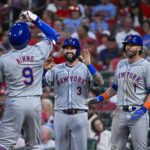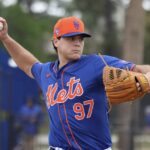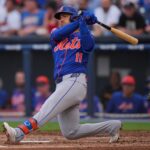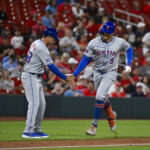Long before becoming General Manager of the Mets, Sandy Alderson was the longtime General Manager of the Oakland A’s. He took over the helm of the A’s after Billy Martin was fired after the 1982 season in which the A’s went 68-94 and finished 5th in the American League West. During his run with the A’s, his teams appeared in three straight World Series from 1988-1990, winning the whole thing in 1989. They also won the American League West in 1992. He was at the helm for 15 seasons before the Moneyball Man, Billy Beane, took over.
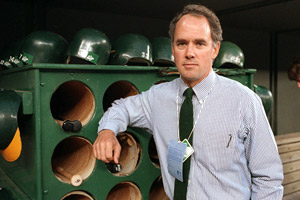
There is a lot of anticipation as to what Sandy will do during the offseason. Will he trade Daniel Murphy? Will he trade for a big bat? Will Bartolo Colon stay or go? Will he trade away some of the big prospects? One thing’s for sure – he likely won’t get beaten in a trade.
Does Sandy’s history of trades give us any indication as to what he will do this offseason? When he’s pulled off deals in seasons past, what did he get in return? What does 20/20 hindsight tell us about what he did during his A’s run? Sandy didn’t make many bad trades.
On December 6, 1982, the A’s traded away two players, Tony Armas and Jeff Newman to the Boston Red Sox. Armas was a 28 year old slugger who finished the season hitting .233 with 28 HR and 89 RBI. Armas would go on to play four seasons with the Red Sox before leaving as a free agent following the 1986 season and in 1984 led the American League with 43 HR and 123 RBI. Jeff Newman was a 34 year old catcher who hit .200 in 83 games for the Red Sox over two seasons. In return, the A’s received Third Baseman Carney Lansford, who was entering his age 26 season and was coming off two seasons where he hit .300 including an AL batting title in 1981. Lansford would go on to play 10 seasons with the A’s over which he hit .288 and is 10th all time on the A’s career hit list with 1,317. The A’s also received Gary Hancock, an outfielder who played 152 games for the A’s over two seasons and right handed pitcher Jerry King who never made it to the majors. Sandy made a good trade on this one.
December 7, 1983 – Sandy traded Rusty McNealy and cash to the Montreal Expos for Ray Burris. McNealy never had a base hit in the major leagues. The 33 year old Burris pitched 211.2 innings for the A’s in 1984, going 13-10 with a 3.15 ERA before being traded after the season. Another good trade for Sandy.
December 5, 1984 – Rickey Henderson, Bert Bradley and cash were traded to the Yankees in exchange for Tim Birtsas, Jay Howell, Stan Javier, Eric Plunk, and Jose Rijo. Bert Bradley never pitched again in the majors after being sent to the Yankees. Henderson was entering his age 26 season and was a four-time All-Star that had led the American League in steals the previous five seasons and spent 4+ seasons in New York before being traded back to the A’s in 1989. Tim Birtsas made 25 starts for the A’s in 1985, his best season, and played 5 seasons in the majors with the A’s and Reds without doing much else afterward. Jay Howell played three seasons with the A’s and was a two-time All-Star for them in 1985 and 1987 while collecting 61 saves. Stan Javier went onto a 17 year MLB career, but during his first stint with the A’s never did better than his 1988 season when he hit .257 with 2 HR, 35 RBI and 20 stolen bases in 125 games. Eric Plunk had a 14 year MLB career and appeared in 3+ seasons with the A’s before being sent back to the Yankees as part of the trade that returned Henderson to the A’s with his best work for the A’s coming in 1989 when he appeared in 23 games out of the pen with a 2.20 ERA and 1.01 WHIP before a midseason trade. Jose Rijo pitched three seasons for the A’s before being traded after the 1987 season, going 17-22 with a 4.74 ERA in 72 games with 49 starts while with the A’s. Sandy lost this trade, however it should be noted that the A’s were a team in rebuilding mode after having finished under .500 the previous three seasons and this trade will be discussed further in this post.
December 7, 1984 – Ray Burris, acquired a year earlier was traded to the Milwaukee Brewers along with Eric Barry and a PTBNL (Ed Myers) for Don Sutton, who was entering his age 40 season. Sutton made 29 starts for the A’s before being traded before the end of the season, going 13-8 with a 3.89 ERA in 194.1 innings. Ray Burris pitched 3 more seasons in the majors, his lowest ERA was 4.81. Neither Barry nor Myers ever made it to the majors. While Sutton didn’t last a full season with the A’s, Sandy got the better part of this trade.
December 8, 1984 – Sandy traded 27 year-old reliever Bill Caudill, who was coming off an All-Star season with the A’s in which he went 9-7 with a 2.71 ERA and collected 36 saves to the Toronto Blue Jays for Dave Collins, Alfredo Griffin and cash. Caudill had one more good season in his arm and made his las MLB appearance in July 1987. Collins was coming off a 1984 season in which he hit .308 and led the American League with 15 triples at age 31. He hit .251 in 1985 and was traded after the season. Griffin played three seasons for the A’s and played in 468 games, including winning a Gold Glove at Shortstop in his first season in Oakland. Sandy won this trade.
March 24, 1985 – Sandy traded two prospects that never appeared in the majors, Ed Puikunas and Dan Winters to the San Francisco Giants for a 36 year old Dusty Baker. Baker played two seasons for the A’s and in 1985 he hit .268 with 14 HR and 52 RBI. Sandy won this trade.
September 10, 1985 – With the A’s out of the race Sandy traded pending free agent Don Sutton to the California Angels for two PTBNL (Robert Sharpnack – the Angels 2nd round pick in the 1985 draft and Jerome Nelson – the Angels 3rd round pick in the 1985 draft). While neither of the prospects ever made it to the majors, one can’t argue that it was a bad trade. Sandy turned a 40 year old free agent-to-be-pitcher into two high draft pick prospects. This was a good trade.
November 13, 1985 – After a poor 1985 season, Sandy traded Dave Collins to the Detroit Tigers for Barbaro Garbey. Collins was released by the Tigers after the 1986 season after the outfielder hit .270 with 1 HR and 27 RBI in 124 games. Collins would continue to play 4 more seasons in the majors as a pinch hitter. Garbey was a 28 year old outfielder / first baseman who hit .257 with 6 HR and 29 RBI in 86 games for the Tigers and was released by the A’s in Spring Training prior to the start of the 1986 season. While Garbey never made it through the spring, I’ll call this a push as it was a trade of two major league players that neither team had a use for.
December 10, 1985 – In a splash trade for Sandy, he acquired Joaquin Andujar from the St. Louis Cardinals for Tim Conroy and Mike Heath. Andujar was coming off back-to-back 20 win seasons for the Cardinals in which he went 41-26 while logging 1021.2 innings over the previous four seasons. Tim Conroy was a 26 year old lefty that had an unspectacular career with the A’s and went 8-13 with an ERA north of 5.00 in two seasons with the Cardinals. Heath was a catcher entering his age 31 season that hit .205 in 65 games for the Cardinals before being traded in August. While this would seem like a small price for a dominant pitcher and this looked like a steal for Sandy, let us not forget Joaquin’s meltdown in game seven of the 1985 World Series in which he was ejected by umpire Don Denkinger (who was the umpire that blew the famous call at first base in Game 6) and smashed up a toilet in the Kansas City clubhouse with a baseball bat. He was facing a suspension from Peter Ueberroth for dealing drugs to Cardinals teammate Lonnie Smith in 1982. A one-year suspension was handed down in February 1986, which was later reduced to community service and making anti-drug donations. Joaquin made 26 starts for the A’s in 1986, going 12-7 with a 3.82 ERA and lasted one more season on Oakland, going 3-5 with a 6.08 ERA in 13 starts in 1987. Despite a diminished Andujar, given the very little Alderson and to give up to acquire him, the 1986 season made this trade a win for Sandy.
March 30, 1986 – Just prior to the start of the 1986 season, Sandy traded four players to the Milwaukee Brewers to acquire right handed starting pitcher Moose Haas, who was entering his age 30 season. Prior to the trade, Haas had a record of 91-79 with a 4.03 ERA over 10 seasons in Milwaukee and was coming off an 8-8 season with a 3.84 ERA in which he made 26 starts and threw 161.2 innings. Haas had become expendable as rookie pitchers Bill Wegman and Juan Nieves made the Brewers rotation out of spring and Alderson landed the Moose by trading soon-to-be 26 year old catcher Charlie O’Brien (who would play 15 seasons in the majors as a light-hitting backup, but at the time had all of 16 MLB games under his belt), former Oakland 1981 first round pick Steve Kiefer (who hit .192 in 105 MLB games), minor leaguer Michael Fulmer (who was out of baseball after the 1986 season), and lefty minor leaguer Peter Kendrick (who was coming off two solid minor league seasons with sub 3.00 ERA’s, but never made it to the majors). In exchange for four non-impact players, Sandy got two seasons out of Haas. In 1986, Haas went 7-2 with a 2.54 ERA in 12 starts while battling injuries, making just four starts totaling 14 innings after May 16th. In 1987, Haas would make 9 starts before making his final MLB appearance on June 19th. It wasn’t a bad trade, but given Alderson only got a good month and a half out of Haas, I’d call this one a draw.
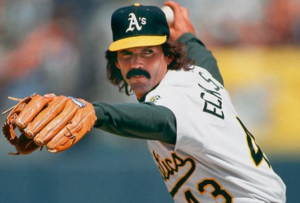 April 7th, 1987 – Just before opening day in 1987, Alderson pulled off a steal, acquiring future Hall of Famer Dennis Eckersley and Dan Rohn in exchange for three players who never made the major leagues – infielder Brian Guinn, right handed pitcher Mark Leonette, and outfielder Dave Wilder. The 32 year old Eckersley was coming off a 6-11 season with a 4.57 ERA in 32 starts for the Cubs in 1986. Eck would transform to a dominant reliever that propelled him to Cooperstown, saving 320 games for the A’s over 9 seasons, making 4 All-Star teams, winning the Cy Young and MVP in 1992 and was a key part of three straight A’s World Series teams, including the 1989 championship team. This was a major win.
April 7th, 1987 – Just before opening day in 1987, Alderson pulled off a steal, acquiring future Hall of Famer Dennis Eckersley and Dan Rohn in exchange for three players who never made the major leagues – infielder Brian Guinn, right handed pitcher Mark Leonette, and outfielder Dave Wilder. The 32 year old Eckersley was coming off a 6-11 season with a 4.57 ERA in 32 starts for the Cubs in 1986. Eck would transform to a dominant reliever that propelled him to Cooperstown, saving 320 games for the A’s over 9 seasons, making 4 All-Star teams, winning the Cy Young and MVP in 1992 and was a key part of three straight A’s World Series teams, including the 1989 championship team. This was a major win.
August 29, 1987 – The A’s were tied for first place in the American League West when Sandy made a trade with the Los Angeles Dodgers to acquire Rick Honeycutt for a player to be named later (Tim Belcher). At the time of the trade, Honeycutt was 2-12 with a 4.59 ERA in 115.2 innings for the Dodgers. Down the stretch he appeared in 7 games for the A’s, going 1-4 with an ERA of 5.32 while making 4 starts. In 1988, he would make 55 appearances out of the bullpen before re-signing with the A’s as a free agent after the 1988 and 1992 seasons and again prior to the 1995 season after spending one season in Texas. Tim Belcher would go on to pitch 14 seasons in the majors including 5 seasons with the Dodgers, during which he would appear in 138 games, making 119 starts with a record of 50-28 and an ERA of 2.99 in 806 innings. Belcher finished 3rd in Rookie of the Year balloting in 1988 and 6th in Cy Young voting in 1989 while throwing 230 innings and leading the National League with 8 shutouts. Honeycutt found a home in Oakland and was an important setup man for the A’s World Series teams. This trade was a win for both sides.
August 30, 1987 – In another stretch run trade, Alderson acquired right handed pitcher Storm Davis from the San Diego Padres in exchange for two players to be named later. Davis made 5 starts for the A’s in 1987, going 1-1 with a 3.26 ERA and made another 64 starts in 1988-89 with 35 victories, including a 19-7 season for the 1989 World Series winning team before departing as a free agent. In exchange, Sandy gave up left handed reliever Dave Leiper who made 69 appearances out of the pen for the Padres and first baseman Rob Nelson who hit .178 in 76 career MLB games. This was a win for Alderson.
December 8, 1987 – After the 1987 season, Alderson traded two parts of the Rickey Henderson trade from three years earlier (Tim Birtsas and Jose Rijo) to the Cincinnati Reds for 36 year old Dave Parker. While his best seasons were behind him, Parker played two years for the A’s, appearing in 245 games while hitting .261 with 34 HR and 152 RBI. Birtsas pitched for three years out of the pen for the Reds. Rijo was unspectacular with the A’s, but shined with the Reds, posting six straight sub-3.00 ERA seasons for the Reds and 87 victories over the next seven seasons. While Rijo went on to bigger and better things with the Reds and was a key starter for the Reds 1990 championship team that swept the A’s in the 1990 World Series, the trade was one that could be considered a win for both teams. Dave Parker, after all, did lead the 1989 World Series winning team with 97 RBI.
December 11, 1987 – In a three team trade with the Los Angeles Dodgers and New York Mets, the A’s acquired Bob Welch and Matt Young from the Dodgers. Welch went on to pitch the final seven seasons of his MLB career with Oakland, earning 96 of his 211 career victories. Welch made 104 starts for the back-to-back-to-back World Series teams, going 61-23, including 27-6 with a 2.95 ERA en route to a 1990 Cy Young Award. Matt Young went on to pitch one unspectacular season with the A’s. What the the A’s give up? The Dodgers received shortstop Alfredo Griffin, who was on the downside of his career and Jay Howell, who had five excellent seasons in the Dodgers bullpen and was the closer in for the 1988 Dodgers team that defeated the A’s in the World Series. The Mets received from the A’s pitcher Kevin Tapani (who only pitched 3 games for the Mets before the Mets flipped him in the Frank Viola trade) who went onto a 13 year MLB career and 143 victories and Wally Whitehurst who appeared in 163 MLB games over 7 seasons. While, like the Parker trade, Sandy traded away a player that would later go on to be a key component of the team that defeated the A’s in the World Series, he acquired Bob Welch and this was a definite trade win.
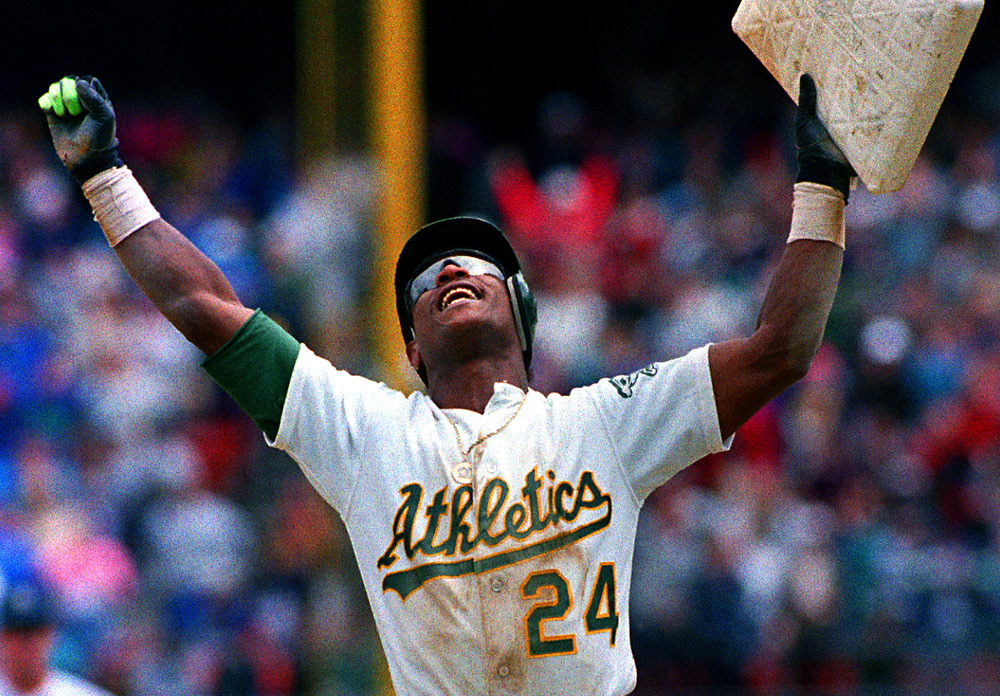 June 21, 1989 – After having traded Rickey Henderson away following the 1984 season, Alderson re-acquired the Man of Steal from the New York Yankees in exchange for Greg Cadaret, Eric Plunk, and Luis Polonia. Cadaret pitched well for the 1988 team and had a 2.28 ERA out of the pen for the A’s before he was traded and went on to make 188 appearances out of the bullpen for the Yankees from 1989-1992. Eric Plunk was traded for Henderson once and was traded once again and made 115 appearances for the Yankees from 1989-1991. Luis Polonia hit .313 for the Yankees in 66 games in 1989 before being traded again the next April. What did Ricky do for the A’s? He hit .294 after the trade while stealing 52 bases in 85 games and helped the A’s win the World Series in 1989. He was the American League MVP in 1990 when he hit .325 with 28 HR, 61 RBI, 65 stolen bases and led the American League with 119 runs scored and a .439 OBP for the American League Champions. In was a minor price to pay and the re-acquisition of Rickey was a big win.
June 21, 1989 – After having traded Rickey Henderson away following the 1984 season, Alderson re-acquired the Man of Steal from the New York Yankees in exchange for Greg Cadaret, Eric Plunk, and Luis Polonia. Cadaret pitched well for the 1988 team and had a 2.28 ERA out of the pen for the A’s before he was traded and went on to make 188 appearances out of the bullpen for the Yankees from 1989-1992. Eric Plunk was traded for Henderson once and was traded once again and made 115 appearances for the Yankees from 1989-1991. Luis Polonia hit .313 for the Yankees in 66 games in 1989 before being traded again the next April. What did Ricky do for the A’s? He hit .294 after the trade while stealing 52 bases in 85 games and helped the A’s win the World Series in 1989. He was the American League MVP in 1990 when he hit .325 with 28 HR, 61 RBI, 65 stolen bases and led the American League with 119 runs scored and a .439 OBP for the American League Champions. In was a minor price to pay and the re-acquisition of Rickey was a big win.
May 13, 1990 – Sandy flipped light hitting outfielder Stan Javier to the Los Angeles Dodgers in exchange for a 35 year old Willie Randolph. Willie would go on to make 80 starts at second base for the 1990 American League championship team hitting .257 with 1 HR and 21 RBI. Javier didn’t have a place to play in an A’s outfield that included Rickey Henderson, Dave Henderson, and Jose Canseco and even though Randolph didn’t do a tremendous amount with the 1990 A’s, Alderson did turn a spare part into a veteran leader for a pennant winning team, so I would count this one as a win.
August 29, 1990 – The A’s were 6.5 games up in the American League West when Sandy made two separate transactions for the postseason roster. Harold Baines was acquired from the Texas Rangers for two players to be named later. Baines hit .266 in 32 games down the stretch and was an All-Star for the 1991 team. The two players he gave up were right handed pitcher Joe Bitker, who appeared in 15 MLB games, and right hander Scott Chiamparino who also appeared in 15 MLB games. This was another win for Sandy.
August 29, 1990 – The other trade made by Alderson on August 29th involved the St. Louis Cardinals. Willie McGee was a pending free agent after the 1990 season and was traded by the 6th place Cardinals who were 16 games out of first place. Despite being traded, Willie had enough plate appearances to qualify for the batting title in the National League and was the NL batting champ in 1990, hitting .335. In 29 games with Oakland, he hit .274 with 0 HR and 15 RBI before departing as a free agent to sign with the Giants. McGee scored 3 runs in 3 games in the ALCS versus Boston, but hit .200 (2 for 10) with 1 run as the A’s were swept by the Reds in the World Series. For the rental, Sandy gave up corner infielder Stan Royer who appeared in 89 MLB games, reserve outfielder Felix Jose who played three seasons for the Cardinals and was an All-Star in 1991, and right handed pitcher Daryl Green, who never appeared in the majors. While Sandy gave up a future All-Star, the A’s didn’t have room for Jose and McGee did play a role in the pennant wining team, although wasn’t a difference maker. This one was a push.
July 26, 1991 – After three straight World Series appearances, the A’s found themselves in third place and 5 games out when Sandy pulled the trigger to acquire 31 year old Brook Jacoby to play third base and fill the void left after a New Year’s Eve snowmobile accident cost incumbent third baseman Carney Lansford all but 5 games of the 1991 season. In 56 games for Oakland, Jacoby hit .213 with 0 HR and 20 RBI before going back to the Indians as a free agent in the offseason. In exchange, Alderson gave up their former 1987 first round pick outfielder Lee Tinsley who never appeared in the majors for Cleveland, but did play in 361 major league games over 5 seasons and minor league pitcher Apolinar Garcia. While the A’s didn’t give up much to acquire Jacoby as a rental, the void wasn’t filled. This one is a push.
July 31, 1991 – The A’s were still 5 games out when Sandy made another move to acquire Ron Darling from the Montreal Expos for left hander Matt Grott (who pitched in 2 MLB games) and right handed pitcher Russell Cormier, who never made it to the major leagues. Darling went 3-7 with a 4.08 ERA in 12 starts down the stretch and returned to the A’s as a free agent for the final four years of his career. For the 1992 AL West division champs, Darling went 15-10 with a 3.66 ERA. This was a win.
August 31, 1992 – The first place A’s were up 6.5 games in the division when they traded 28 year old Jose Canseco to the Texas Rangers. At the time of the trade, the 1992 All-Star and former American League MVP was hitting .246 with 22 HR and 72 RBI. The A’s got back pending free agent outfielder Ruben Sierra (whom later re-signed in the offseason and went on to be an All-Star in 1994), pending free agent Jeff Russell (who appeared in 8 games out of the pen before departing signing elsewhere after the season), and right handed starting pitcher Bobby Witt who made 63 starts for the A’s before departing as a free agent after the 1994 season. With the hindsight of the steroid era, this trade is definitely interesting. The A’s had a comfortable lead in the pennant race when they traded away a player who was second on the team in RBI and a former MVP in his prime for two rental players and a back of the rotation starter that pitched all of one inning for them in the post season. Even knowing what we know now about Jose Canseco, this one is a loss.
November 17, 1992 – The A’s record took a nosedive from 96-66 in 1992 to 68-94 in 1993. That offseason, Sandy traded light hitting shortstop and former 1988 Rookie of the Year Walt Weiss to the Florida Marlins in exchange for Eric Helfand and a player to be named later. Helfand hit .171 in 53 career MLB games, all with the A’s. The PTNBL was Scott Baker who pitched in 1 MLB game. Walt Weiss went on to start 153 games at short for the Marlins and 8 more MLB seasons. To be fair, Weiss’s replacement at short, Mike Bordick, did outproduce him offensively. Still, given the return Sandy received for Weiss, this one is a loss.
January 14, 1993 – Prior to the 1993 season, the A’s traded away incumbent DH Harold Baines to the Orioles. Baines went off to hit .313 for Baltimore in 1993 with 20 HR and 78 RBI. The A’s received reliever Bobby Chouinard, who appeared in 111 MLB games and pitcher Allen Plaster who never appeared in the majors. This was another loss.
July 31, 1993 – The A’s were well out of the pennant race when Sandy traded Rickey Henderson yet again. The Blue Jays traded for the outfielder who was a pending free agent and Rickey hit .215 in 34 games for the World Series champs. The Blue Jays sent right handed pitcher Steve Karsay who had an unspectacular career with the A’s and a PTBNL (Jose Herrera) who appeared in 141 games for the A’s over two seasons. Even though they didn’t get anything spectacular in return, they got something in return for a pending free agent. This was a win. Oh, and Rickey re-signed with the A’s in the off season.
July 28, 1995 – The A’s were 13 games out in the pennant race when Alderson shipped Ruben Sierra, who was hitting .265 with 12 HR and 42 RBI to the Yankees along with right handed pitcher Jason Beverlin (7 MLB appearances) in exchange for Danny Tartabull. Tartabull was traded in the offseason and out of the majors two years later. Sierra played 20 MLB seasons until 2006 and was flipped a year later by the Yankees for Cecil Fielder. Tartabull hit .261 in 24 games for the A’s. Sandy lost this one.
January 9, 1996 – After the death of A’s owner Walter A. Haas, Jr. in 1995, new ownership ordered Alderson to slash payroll. Starting pitcher Todd Stottlemyre, who had signed as a free agent the previous season and earned $2.05 million in 1995 was traded to the St. Luis Cardinals for outfielder Allen Battle (who hit .192 in 47 games for Oakland), pitcher Carl Dale (who appeared in 4 MLB games), pitcher Jay Witasick (who pitched in 29 games for the A’s before being traded and pitched 12 seasons in the majors), and Cardinals 1994 first round pick pitcher Bret Wagner (who never played in the majors). Stottlemyre would win 35 games for the Cardinals. Loss for Sandy.
January 22, 1996 – Danny Tartabull was dealt to the Chicago White Sox in exchange for Andrew Lorraine (who appeared in 12 games with a 6.37 ERA for the A’s in 1997 and 59 MLB games) and career minor league outfielder Charles Poe. Tartabull went on to hit .254 with 27 HR and 101 RBI for the Sox in 1996 and was out of the majors after 1997. Another loss for Sandy.
February 13, 1996 – 40 year old Dennis Eckersley was traded to the St. Louis Cardinals and went on to save 66 games over the next two seasons and was the closer for the Cardinals, who lost in the National League Championship series. The A’s received Steve Montgomery, who would pitch 12 games for the A’s and 72 games in his MLB career. Loss.
January 27, 1997 – Before the 1997 season, Sandy brought back Jose Canseco whom he had traded away four and a half years earlier. In his one season back with Oakland, he hit .235 with 23 HR and 74 RBI. All the A’s gave up in return was starter/reliever John Wasdin (who had a career 5.28 ERA) and cash. Win for Sandy.
June 27, 1997 – The A’s were 14 games out in the race when the A’s shipped Geronimo Berrora to the Orioles. Berrora hit .290 with 36 HR and 106 RBI for the A’s in 1996 and was hitting .310 with 16 HR and 42 RBI in 73 games before being dealt. The A’s got back Jimmy Haynes who made 71 starts with an ERA of 5.40 over three seasons for the A’s and a PTBNL (Mark Seaver). Seaver never appeared in the majors. Berrora’s career quickly fell apart, hitting only 2 home runs after the 1997 season. Berrora was the DH on the AL East winning Orioles. Even though Haynes didn’t have a great run, the monumental fall of Berrora after 1997 makes this one a win for Sandy.
July 31, 1997 – In his last major trade as General Manager of the Oakland A’s, Sandy Alderson traded away Mark McGwire to the St. Louis Cardinals. McGwire went on to hit a tainted 70 home runs in 1998 to break Roger Maris‘ record. The A’s received three players in return – Eric Ludwick (6 appearances for the A’s and 31 in his MLB career with an 8.35 ERA), T.J. Mathews (who would have an 8 year MLB career as a middle reliever, including 5 years and 210 appearances with the A’s and a career 3.82 ERA), and Blake Stein (who made 21 starts for the A’s with an ERA of 6.60 and pitched in 117 MLB games over 5 seasons). Despite what we now know about McGwire, this was a major loss.
That’s 19 trade wins, 9 trade losses, and 4 trade ties.
By and large, Sandy was always a winner when it comes to making trades as the A’s GM. He didn’t come up on the losing end often, however it can’t help to be noticed that his trend did start to shift and he came up on the losing end more often once he was ordered to cut payroll. When he wasn’t hampered by payroll, his record was stellar when it came to trades. His biggest losses when his hands weren’t tied involved trading Rickey Henderson when the team was in rebuilding mode and trading away Jose Canseco when he was in his prime.
Even with the “loss” in the Henderson trade when looking at that trade in a bubble, this trade helped shape the A’s World Series teams. While only Jay Howell performed well while a member of the A’s, the later acquisition of Dennis Eckersley allowed for Howell to be flipped as part of the acquisition that landed Bob Welch. Two other parts of the Henderson (Tim Birtsas and Jose Rijo) trade were later flipped to acquire Dave Parker. Eric Plunk was later part of the acquisition to re-acquire Henderson. The fifth player, Stan Javier, was later flipped for Willie Randolph, another starter on the 1990 World Series team. So even the “loss” of that trade later turned into a key starter, a top RBI man, and a starting second baseman for their championship caliber teams.
All in all, not too shabby.




